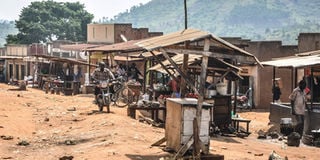Oil pipeline to displace 800 in Mubende

Area. Buganyi Trading Centre in Madudu Sub-county in Mubende District is one of the areas that will be affected by the proposed oil project. PHOTO BY JOSEPHINE NNABBAALE
What you need to know:
- Background. When the idea of a pipeline was first conceptualised in the commercialisation framework signed in February 2014 between government and the oil companies— Tullow, Cnooc and Total E&P, it seemed vague, then came consideration of the route—the options being Kenya, Hoima to Lamu via Teso/Karamoja and northern Kenya, Hoima to Malaba to Mombasa, and from Hoima to Mutukula to either Tanga or Dar-es-Salaam, still, it appeared unclear.
- Eventually, it was agreed that it would go south via Mutukula to Tanga—Tanzania’s less busy port.
At least 813 residents in Mubende District living on the demarcated route for the East African Crude Oil Pipeline Project (EACOP) have to look for alternative land.
The affected residents are spread in 29 villages and covering three sub-counties of Madudu, Butoloogo, and Kitenga.
The Mubende District chairperson, Mr Francis Kibuuka Amooti, on Tuesday said valuation of the demarcated pipeline land is complete and the project affected persons have appended signatures endorsing the giveaway of the land so that compensation is processed.
“As residents get tax identification numbers and open bank accounts, government should ensure that they are fully compensated in time so that they can get alternative land,” Mr Amooti added.
A government plan indicates that the 1,445-kilometre crude oil export pipeline is expected to run from Hoima through the districts of Kakumiro, Kikuube, Kyankwanzi, Mubende, Gomba, Ssembabule, Lwengo and Rakai at the border to Tanga port at the Indian Ocean in Tanzania.
Uganda’s section of the pipeline from Hoima to Mutukula is 296 kilometres and is estimated to cost $700m (approximately Shs2.4 trillion).
The construction works of the pipeline is expected to commence in the 2020/2021 Financial Year.
Ms Stella Amony, the communications officer at Total E&P Uganda, a firm that will undertake the project, said the 24-inch-diameter pipe will be buried underground for security and safety reasons.
“The construction works will entail land clearance and excavation, which will inevitably lead to physical disturbance of the people who reside in the area,” Ms Amony said.
“The land will also be used for permanent ground installations such as pumping stations, pressure reduction stations and marine storage and for a permanent right of way,” she added.
The villages where the pipeline will pass in Mubende include Nyondo, Kigondo, Buganyi, Katuula, Kisagazi, Kitanda, Kijaagi, Bujuuko, Kijaguzo, Lulongo, Kabulasoke, Kyambogo, Kamusenene, Bututi, Sunga and Kirangwa.
Others are Lugala, Kagoma, Busepo, Nalyankanja, Kalambansaizi, Saaka, Buzooba, Nsengwe, Rusikizi, Rwamasengyero, Busooba, Butayunja and Buswabwera.
The pipeline represents the largest trade deal between Tanzania and Uganda currently comprising $120m (Shs425b) annually in each direction.




